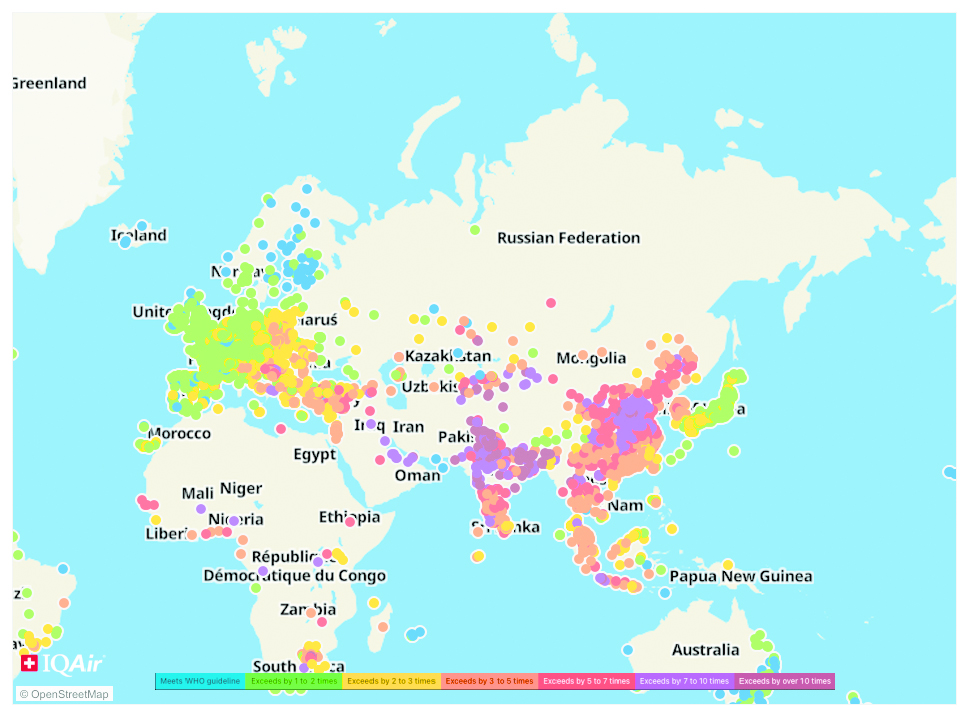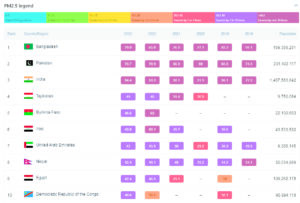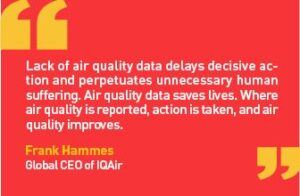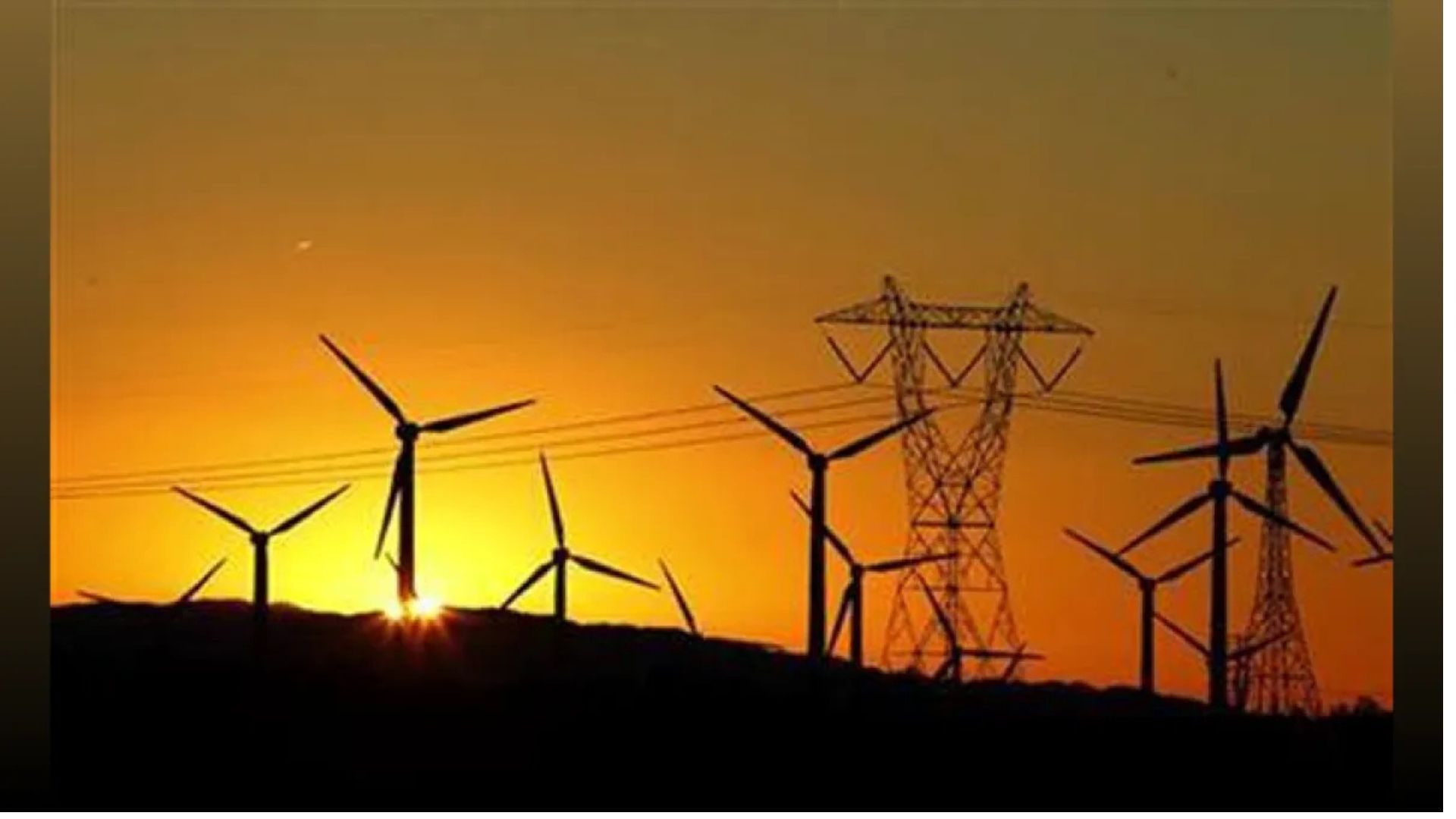
The fundamental rules of survival are clear: while humans can survive for weeks without food and days without water, they can only last minutes without air. Air stands as the most crucial resource for human life, yet the reality is that much of the world breathes in polluted air on a daily basis.
According to the 2023 World Air Quality Report released by IQAir, a Swiss firm specializing in real-time air quality monitoring and publishing annual assessments since 2018, only 10 countries or territories in the past year achieved air quality levels that met the standards set by the World Health Organization for clean air.
IQAir utilized the average concentration of PM2.5 (particulate matter with a diameter of 2.5 micrometres or smaller) as its primary indicator of air quality for each country or territory. This measurement was based on data from cities with publicly-available information. PM2.5 is a harmful component of air pollution derived from various sources, including emissions from coal and oil combustion, as well as dust storms and wildfires.
According to the World Health Organization (WHO), PM2.5 particles can infiltrate the lungs and enter the bloodstream, thereby impacting major organs within the body. Prolonged exposure to PM2.5 is linked to cardiovascular and respiratory health complications such as strokes and lung cancer. Alarmingly, air pollution contributes to an estimated 7 million premature deaths globally each year.
According to WHO guidelines, exposure to an annual mean PM2.5 concentration should not exceed 5 micrograms per cubic meter (5 µg/m3). Among the 134 countries and territories assessed by IQAir, only Sweden, Finland, Estonia, Puerto Rico, Australia, New Zealand, Bermuda, Grenada, Iceland, Mauritius, and French Polynesia achieved air quality levels that met this threshold in 2023.

Oceania was the cleanest region in the world
Oceania, consisting of Australia, New Zealand, and French Polynesia, retained its status as the region with the cleanest air in 2023, as highlighted in IQAir’s report. Remarkably, each of the countries and territories within Oceania succeeded in meeting the standards set by the World Health Organization (WHO). Furthermore, Oceania boasts the highest proportion, with 55% of reported cities achieving compliance with the WHO standard.
Asia stands as the most polluted region in the world
Asia stands as the most polluted region in the world, as revealed by IQAir’s report. Almost all of the 100 cities with the most polluted air globally are situated in Asia, with a staggering 83 of them located in India alone. In each of these cities, PM2.5 levels surpassed the World Health Organization’s standard by 10 times or more.
Topping the list as the most polluted city is Begusarai, located in the western state of Bihar, India, with a population exceeding half a million residents. In the past year, Begusarai recorded PM2.5 levels reaching 118.9 µg/m3—equivalent to 23 times the WHO standard.
Central and South Asia are home to the top four most polluted countries globally—Bangladesh, Pakistan, India, and Tajikistan. Shockingly, 31% of the cities in this region reported PM2.5 levels exceeding the WHO standard by more than 10 times, a proportion significantly higher than any other region assessed in the report.
IQAir attributed Asia’s air pollution crisis to various factors, including substantial greenhouse gas emissions from coal-fired power plants and the burning of peat bogs. Additionally, the El Niño weather phenomenon has contributed by delaying the onset of the rainy season, which typically helps alleviate PM2.5 levels.
Europe witnessed improvement
Among the 43 nations monitored in Europe, the annual average PM2.5 levels experienced a decline in 36 of them, an increase in six, and remained unchanged in one. Despite Bosnia Herzegovina retaining its position as the most polluted country in the region, with an annual average PM2.5 level of 27.5 µg/m3, there has been an 18% reduction from 2022.
Notably, Croatia demonstrated significant improvement, with its annual average PM2.5 level decreasing by over 40% compared to 2022. Additionally, while 39% of European cities recorded an annual average PM2.5 level of 10 µg/m3 or lower in 2022, the proportion increased to 54% in 2023, indicating a positive trend toward cleaner air in the region.

North America emerged as the most monitored region
North America emerged as the most monitored region in the 2023 air quality report, with 3,242 cities analyzed, representing 40% of the total cities included in the report. Meanwhile, Latin America and the Caribbean continued to expand their air-quality monitoring network significantly, with the establishment of new government-operated and non-government-operated monitoring stations in numerous cities and countries. This expansion included previously unrepresented locations such as the Bahamas and Ecuador.
In a notable shift, Canada surpassed the United States in terms of air pollution for the first time since IQAir began publishing its annual reports. This change was largely attributed to the extensive wildfires that ravaged the country from May to October of the previous year. In May, the monthly average air pollution in Alberta soared almost ninefold compared to the same period in 2022.
The United States also experienced an increase in air pollution, with the nationwide average PM2.5 level rising from 8.9 µg/m3 in 2022 to 9.1 µg/m3 in 2023. Smoke drifting southward from Canada’s wildfires contributed to this uptick. Columbus, Ohio, retained its position as the most polluted major U.S. city for the second consecutive year, with an average PM2.5 level of 13.9 µg/m3. In contrast, Las Vegas, Nevada, was ranked as the least polluted major U.S. city, with an average PM2.5 level of 4.9 µg/m3.
South Africa was the least monitored region
In 2023, the sole non-Asian city among the 100 most polluted cities worldwide was Benoni, South Africa, with a PM2.5 level of 54.9 µg/m3, surpassing the WHO standard by 11 times. However, Africa as a whole confronts a significant challenge in addressing air pollution: a scarcity of data.
Despite the rapid urbanization across the continent, only 24 out of 54 countries, representing 66% of the population, possess adequate air quality data to be included in IQAir’s report. Notably, Chad, which was ranked as the most polluted country globally in IQAir’s 2022 report, was excluded due to the absence of publicly available monitoring data.
Frank Hammes, global CEO of IQAir, emphasized the critical role of air quality data in prompting decisive action and mitigating human suffering. He asserted, “Lack of air quality data delays decisive action and perpetuates unnecessary human suffering. Air quality data saves lives. Where air quality is reported, action is taken, and air quality improves.”















